Q&A
Frequently asked questions
Terminology related to sunscreens,
UV rays, UV, SPF, and so on…
Do you feel that “I’ve heard of them
But I’m not sure what they mean”?
We Will answer those questions for you!
What are UV rays?
Ultraviolet (UV) rays are rays from the sun that are invisible to human eyes.
UV rays, which adversely affect our skin and eyes, are divided into three different types according to the wavelengths.
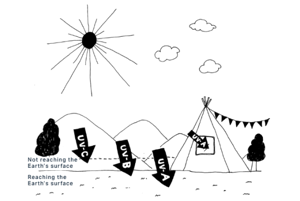
1. UVA, which accounts for the majority (95%) of the UV radiation that reaches Earth from the sun:
Having a longer wavelength, UVA radiation penetrates window glass and clouds and reaches the deeper layers of skin. It is the type of UV radiation that gradually affects the skin in daily life.
2. UVB, which is small in amount but has a powerful impact on the skin:
UVB only accounts for about 5% of the UV rays that reach us from the sun but this radiation is more than 1,000 times powerful than UVA in terms of producing sunburn that causes reddish inflammation.
3. UVC, which is even more dangerous but does not reach the Earth’s surface:
UVC is extremely dangerous, and even more damaging to the skin than UVB. However, it does not reach the Earth’s surface thanks to the ozone layer which blocks this type of UV radiation.
What are SPF and PA labeled on sunscreens?
Look at the PA to protect yourself from UVA!
The “PA” labeled on sunscreen products indicates the level of protection against UVA with the number of “+.” The number of +s range from one to four, with more providing more effectiveness.
Look at the SPF to protect yourself from UVB!
The “SPF” labeled on sunscreen products refers to how much protection can be provided against sunburn that causes reddish inflammation.
Choose products with around SPF50 when going out to the beach.
Isn’t UV protection needed only during summer?
Summer is not the only time to watch out for UV rays. They reach and damage our skin all year round.
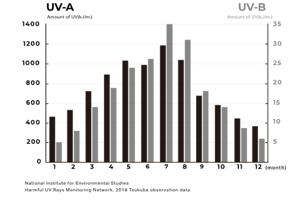
While UVA peaks in July (summer), it reaches a third of its peak even in December, when it is at its lowest.
UVB is at its lowest in January, however it still reaches us at about one-seventh of its July peak. Even in spring, UVB is twice as strong in March compared to December, and 1.5 times greater in April. We can easily be careless in early spring when it is not as warm yet, so please be careful. To avoid unexpected sunburn, it is important to take measures against UV rays as early as you can.
Is it enough to protect against direct sunlight?
- There are two types of UV rays: Direct light and scattered light. The majority of UV rays that reach the ground are scattered light that falls from various angles.
- Even if you turn your back to the sun or wear a hat or sun umbrella, you may be able to avoid direct light on your face, but not be able to protect yourself from all UV rays.
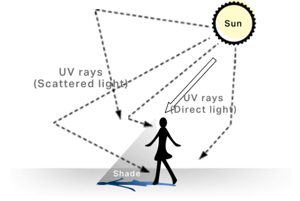
I want to know how sunscreen works!
Sunscreens contain ingredients that absorb UV rays to prevent them from reaching the inner layers of skin and powder ingredients that scatter UV rays to prevent them from reaching skin. When you apply a sunscreen to your skin, it will form a thin film over the skin to stop UV rays from reaching the skin directly.
These “ingredients that prevent UV rays from reaching skin” are classified into the following two types:

1) UV scattering agent
Reflects UV rays to prevent them from reaching skin
2) UV absorbing agent
Absorbs UV rays, converts them into heat, and releases it
ALLIE contains a well-balanced mix of UV absorbing and scattering agents to block UV rays and protect skin.
What is ADVAN, a technology adopted by ALLIE?
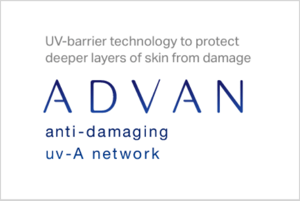
Blocking UV rays & creating a translucent finish
<ADVAN>, adopted by ALLIE, is a UV-blocking technology that achieves “high clarity” using a plate-like UV scattering agent.
1. Blocks UVA, which will cause damage to skin such as a reduction in firmness following prolonged exposure.
2. Fits skin thinly and evenly to leave it fine-textured and smooth.
3. Does not look unnaturally white at the same time.
What is a Beach
Friendly formula?
This refers to environmentally friendly design (water environment risk assessment completed).
This formula is designed taking into consideration product usage leading to leaks in daily life and into the environment during leisure time, eliminating concerns for impact on the water ecosystem.
The water environmental impact is evaluated based on water environment risk assessment frameworks with reference to publicly available guidance documents.
What are the laws of
these regulations?
The laws prohibit bringing in, selling, or using at beaches sunscreens that contain regulated ingredients. Specifically, a bill was passed in Hawaii in July 2018 to regulate the sale of sunscreens that contain certain UV absorbers, and it went into effect in January 2021. In addition, the sale and use of these products are banned in countries and regions including the Virgin Islands, Aruba and Thailand National Parks.
Can ALLIE products be used on
infants and children?
ALLIE sunscreens have been researched and developed for adult skin, but can be also used on children with no skin problems. Please use with caution as it may not suit skin in rare cases.
Can ALLIE products be used on
pregnant women?
Although we have confirmed the safety of our products, pregnancy can cause sensitivity to various stimuli and fragrances. Please avoid using ALLIE products if you are concerned.
What should I do if ALLIE CHRONO BEAUTY MILK UV EX is not
dispensing well, or if the mixing ball does not make sounds when shaken?
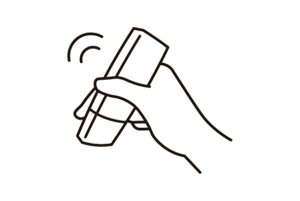
If ・The solution isn’t dispensing well, or
・There are no clicking sounds of the mixing ball even when the container is shaken,
Turn the container upside down with the cap on and shake well. Then try to dispense the solution.
If the solution still does not come out or the container does not make clicking sounds when shaken, please contact Kanebo Cosmetics (kanebo-cosmetics.co.jp) through the CONTACT page.
